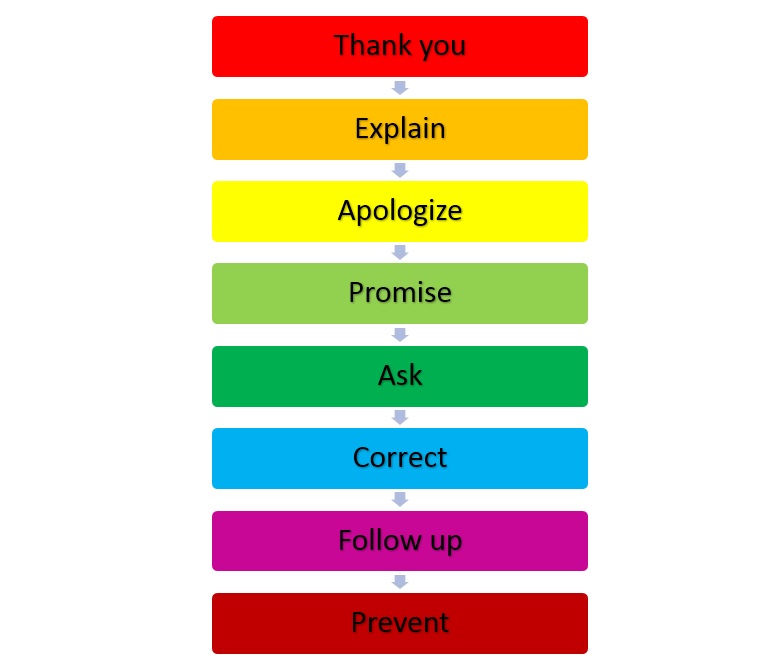From a psychological point of view, the complaint is negative information. Janelle Barlow and Claus Moller in their book A Complaint Is a Gift: Recovering Customer Loyalty When Things Go Wrong advise you to treat this information as a source of new opportunities, as a gift, because the customer who left a complaint shows you what is wrong in your company and thus allows you to correct the situation.
Customer complaints tell the organization how to improve their service and products, and therefore help save the business. In many cases, information extracted from customer complaints cannot be obtained in any other way. Customer complaints are the most effective and cheapest way to get information about customers’ evaluation of the company’s products or services.
Janelle Barlow and Claus Moller developed a special gift formula, which consists of 8 steps and helps in dealing with consumer complaints. The gift formula is a sequential process and contains the following steps:

8 Steps Formula
1. Thank you
There is no better way to show a person your goodwill than to say “thank you”. Don’t think about how well-founded the customer’s complaint is. You should just consider it valuable information – a gift.
2. Explain
Explain why you welcome the complaint. You need to add a “thank you” by saying a few words about how this complaint will help you better understand the problem.
3. Apologize
Apologize for the mistakes. It is very important to apologize to the customer, but an apology should not be the first step.
4. Promise
Promise to take immediate action to resolve the problem. After making an apology, do not immediately ask questions — do not start interviewing the client. Promise to take steps to resolve the situation.
5. Ask
Find out the necessary information. Ask only the most necessary questions. You need to know in advance what information you will need. This should be part of your company’s complaint handling system. Make sure that you have collected all the necessary information, otherwise, you will have to contact the client again.
6. Correct
Quickly correct the mistakes. Make sure you keep your promise. The customer will be satisfied if you quickly solve their problem. Such a rapid response speaks volumes about your serious attitude to customer service.
7. Follow up
Follow up on the customer’s satisfaction. Make sure that the customer is happy. Call your customers to find out what happened. Ask them directly if they are satisfied with your actions. If you do this, customers will probably continue to use your services. It may be appropriate to tell them about your actions to avoid similar situations in the future — let them be happy that their complaint helped the company. Thank them again.
8. Prevent
Prevent mistakes in the future. Inform the company’s employees about the complaint — so that such a problem can be prevented in the future. Fix the system, don’t blame the staff. Punish the process, not the people. Staff will be more willing to report complaints to management if they know that this policy will apply to them.
If a customer has sent you a written complaint, you should immediately pay attention to it, since the client has not spared his time and effort to write you a letter. Respond immediately to written complaints. Even if you don’t know how to solve the problem yet, please send a confirmation that you have received the complaint. The client will know that their email has reached the goal and that their question is being addressed.
Janelle Barlow and Claus Moller advise to follow the seven steps in response to written complaints
1. Thank, explain, and apologize.
2. Explain what steps you have already taken and what changes you have made as a result of the complaint. Specify exactly what you did to handle the client’s situation.
3. Concede the client is right. It is not necessary to win arguments and lose customers.
4. Make your response personal. Use the same language and wording that the client used to describe the complaint.
5. Be simple but accurate. Don’t confuse the client with jargon or technical terms.
6. Take one step beyond the client’s expectations. Send a small gift with your response.
7. Follow up with the customer to make sure they are happy with how the complaint was handled. Be sure that your company has drawn the correct conclusions from the complaints. Keep in touch with your customers, as this will help you constantly improve your business.
Make your organization complaint friendly, it is necessary to develop a complaint-handling policy, which will benefit customers. The authors cite four principles of a complaint friendly policy.
4 Principles of a Complaint Friendly Policy
1) remember that the most important thing is a dissatisfied customer
2) make sure that your policy is consistent with all parts of the organization
3) don’t forget to reward employees who successfully solve the problems of dissatisfied customers
4) create a structure that allows all customer complaints to flow easily and smoothly from staff to superiors.
The process of creating an organization that is friendly to complaints sometimes requires rebuilding internal structures. Janelle Barlow and Claus Moller suggest the steps that need to be to create a complaint friendly company.

Complaint Friendly Company
1. Create an implementation team and prepare it in advance
The company forms an implementation team that consists of representatives of top management and various departments. The implementation team develops a plan that includes internal quality auditing, a staff audit who handles complaints, distribution of the complaints program within the organization, and development of a system for evaluating and tracking complaints.
2. Compose a complaints policy
At this stage, you develop an official policy for dealing with complaints, if there is no such policy, or correct the existing policy, as well as identify organizational obstacles to a good attitude to complaints. You need to find systems that do not work for customers.
3. Use workplace teams and departments to process complaints
Departments make lists of the most common complaints and give them to the implementation team to study, then the implementation team analyzes these lists and identifies patterns. Departments should enthusiastically support policies that are designed to meet complaints.
4. Train your staff
All employees of the organization must be trained to deal effectively with customer complaints. Use the gift formula in the training. Then stuff develops an action plan to resolve consumer complaints as effectively as possible.
5. Install a complaint toolbox for staff
This set of tools should contain checklists for effective complaint management, procedures for monitoring customer satisfaction, suggestions for ways to encourage complaints and facilitate their submission, methods for tracking complaints, and a system for using complaints to improve the quality of work.
6. Maintain your momentum
Update regularly your customer retention statistics and share them with your employees at all levels. Report progress to your employees, encourage them to work successfully with complaints, and award bonuses for effectively resolving complaints, but not for reducing the number of complaints.
7. Use the same methods for internal complaints
Make sure that all of the above applies to internal complaints as well, so that everyone has a chance to improve the company by demanding quality both inside and outside the company.
Remember that as soon as you implement a complaint friendly policy, you must support it.
The book A Complaint Is a Gift: Recovering Customer Loyalty When Things Go Wrong contains psychological profiles of complainants, describes the approach to each category and provides effective and detailed advice on how to respond to complaints. The authors show many real-life examples in the book that tells how companies are helped by proper handling of complaints, as well as how companies fail if they ignore their client’s comments.
Read more marketing and sales Book Reviews in the special section of the website.





